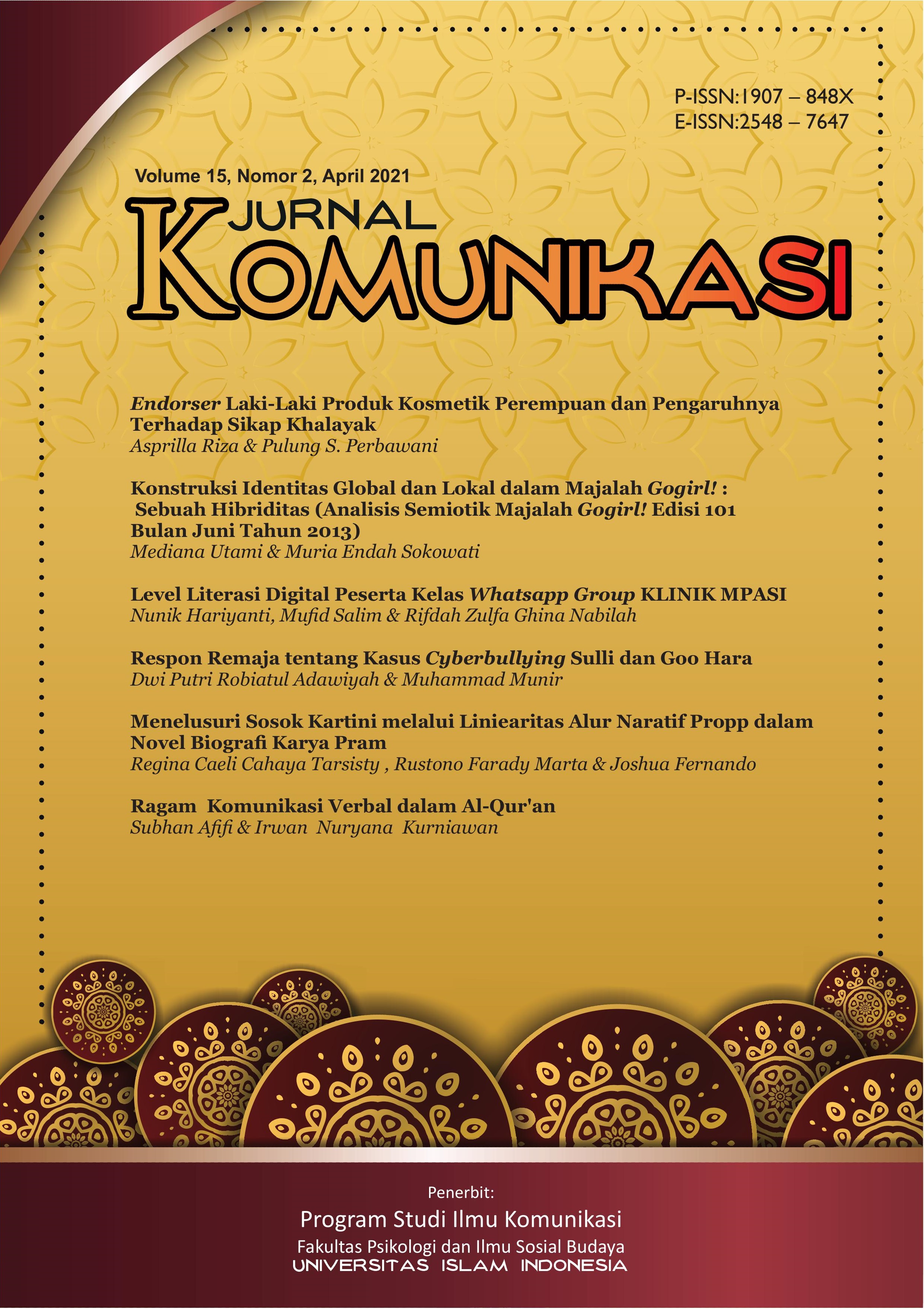Main Article Content
Abstract
Abstract. : This research focuses on describe the position of local and global identities in hybridity. In explain the construction of local and global identities on Gogirl!, the author used semiotics of Roland Barthes. Hybridity is a resistance of local culture to global domination. Magazine assimilated the elements of global culture, devoid eliminated or defend the local elements. In this case, there are certain hybridity mechanisms that has been done, namely the use of hodgepodge language, a blend of English and bahasa Indonesia; the usage of western elements as inspiration; and maintaining the spirit of localism. The hibridity of GoGirls! is a form of negotiation to provide opportunity on the present of local identity. As an inferior subject, local identity becomes an active subject in expressing its identity at the global level through hybridity.
Keywords: Hybrid Culture, Hibridity, Global Culture, Local Culture,
Magazine.
Article Details
Authors who publish with this journal agree to the following terms:
- Authors retain copyright and grant the journal right of first publication with the work simultaneously licensed under a Creative Commons Attribution License that allows others to share the work with an acknowledgement of the work's authorship and initial publication in this journal.
- Authors are able to enter into separate, additional contractual arrangements for the non-exclusive distribution of the journal's published version of the work (e.g., post it to an institutional repository or publish it in a book), with an acknowledgement of its initial publication in this journal.
- Authors are permitted and encouraged to post their work online (e.g., in institutional repositories or on their website) prior to and during the submission process, as it can lead to productive exchanges, as well as earlier and greater citation of published work (See The Effect of Open Access).
References
- Christomy, T., & Yuwono, U. (2004). Semiotika Budaya. Depok: Pusat Penelitian Kemasyarakatan dan Budaya Direktorat Riset dan pengabdian pada Masyarakat Universitas Indonesia.
- Ida, R. (2016). Metode Penelitian Studi Media dan Kajian Budaya. Jakarta: Kencana.
- Mubah, A. S. (2015). Isu-isu Globalisasi Kontemporer. Yogyakarta: Graha Ilmu.
- Ritzer, G. (2006). Mengkonsumsi Kehampaan di Era Globalisasi. Yogyakarta: Andi Offset.
- Rivers, W. L., Jensen, J. W., & Peterson, T. (2003). Media Massa & Masyarakat Modern. Jakarta: Kencana Prenada Media Group.
- Santoso, B. (2006). Bahasa dan Identitas Budaya. Sabda, 1(1), 44-49. DOI: https://doi.org/10.14710/sabda.1.1.44-49
- Maunati, D. Y. (2004). Identitas Dayak, Komodifikasi & Politik Kebudayaan. Yogyakarta: LkiS Yogyakarta.
- Surahman, S. (2013). Dampak Globalisasi Media Terhadap Seni dan Budaya Indonesia. Lontar, 2 (1), 29-38. DOI: https://doi.org/10.30656/lontar.v2i1.334
- Ibrahim, I. S., & Akhmad, B. A. (2014). Komunikasi dan Komodifikasi: Mengkaji Media dan Budaya dalam Dinamika Globalisasi. Jakarta: Yayasan Pustaka Obor Indonesia.
- Huddart, D. (2006). Homi K. Bhabha. London: Routledge Taylor & Francis Group.
- Bhabha, H. K. (1994). The Location of Cluture. London: Routledge.
- Nugroho, W. W. (2018). Karakteristik Bahasa Toni Blank: Kajian Psikolinguistik, Teori, dan Praktik. Yogyakarta: UGM PRESS.
- Szatrowski, P. E. (2014). Language and Food: Verbal and Nonverbal Experiences. Amsterdam: Jhon Benjamin Publishing Company.
- Banea, G. K. (2013, Juni 1). Cheap and Healthy Meal For a Week. Beauty Tips, hal. 170-171.
- Qodir, D. Z. (2010). Muhammadiyah Studies: Reorientasi Gerakan dan Pemikiran Memasuki Abad Kedua. Yogyakarta: Penerbit Kanisius.
References
Christomy, T., & Yuwono, U. (2004). Semiotika Budaya. Depok: Pusat Penelitian Kemasyarakatan dan Budaya Direktorat Riset dan pengabdian pada Masyarakat Universitas Indonesia.
Ida, R. (2016). Metode Penelitian Studi Media dan Kajian Budaya. Jakarta: Kencana.
Mubah, A. S. (2015). Isu-isu Globalisasi Kontemporer. Yogyakarta: Graha Ilmu.
Ritzer, G. (2006). Mengkonsumsi Kehampaan di Era Globalisasi. Yogyakarta: Andi Offset.
Rivers, W. L., Jensen, J. W., & Peterson, T. (2003). Media Massa & Masyarakat Modern. Jakarta: Kencana Prenada Media Group.
Santoso, B. (2006). Bahasa dan Identitas Budaya. Sabda, 1(1), 44-49. DOI: https://doi.org/10.14710/sabda.1.1.44-49
Maunati, D. Y. (2004). Identitas Dayak, Komodifikasi & Politik Kebudayaan. Yogyakarta: LkiS Yogyakarta.
Surahman, S. (2013). Dampak Globalisasi Media Terhadap Seni dan Budaya Indonesia. Lontar, 2 (1), 29-38. DOI: https://doi.org/10.30656/lontar.v2i1.334
Ibrahim, I. S., & Akhmad, B. A. (2014). Komunikasi dan Komodifikasi: Mengkaji Media dan Budaya dalam Dinamika Globalisasi. Jakarta: Yayasan Pustaka Obor Indonesia.
Huddart, D. (2006). Homi K. Bhabha. London: Routledge Taylor & Francis Group.
Bhabha, H. K. (1994). The Location of Cluture. London: Routledge.
Nugroho, W. W. (2018). Karakteristik Bahasa Toni Blank: Kajian Psikolinguistik, Teori, dan Praktik. Yogyakarta: UGM PRESS.
Szatrowski, P. E. (2014). Language and Food: Verbal and Nonverbal Experiences. Amsterdam: Jhon Benjamin Publishing Company.
Banea, G. K. (2013, Juni 1). Cheap and Healthy Meal For a Week. Beauty Tips, hal. 170-171.
Qodir, D. Z. (2010). Muhammadiyah Studies: Reorientasi Gerakan dan Pemikiran Memasuki Abad Kedua. Yogyakarta: Penerbit Kanisius.




